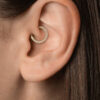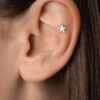Antitragus Piercing Beginner’s Guide
Antitragus Piercing Beginner’s Guide: The antitragus is the small piece of cartilage located just above the earlobe and opposite the tragus. An antitragus piercing is a type of ear piercing that involves a needle being inserted through the antitragus cartilage. This type of piercing has become increasingly popular in recent years, and is a unique way to add some personality to your ear piercing collection.
Importance Of Cartilage Thickness
Before getting an antitragus piercing, it’s important to make sure that the cartilage is thick enough to handle the piercing. Some people may have a thinner piece of cartilage in this area, which can make healing more difficult and increase the risk of complications. It’s also important to note that this type of piercing may take longer to heal than other ear piercings, as the cartilage takes longer to heal than the skin.
Process Of Getting Antitragus
The process of getting an antitragus piercing is similar to that of other ear piercings. The piercer will mark the area where the piercing will be placed, and then clean the area thoroughly. A needle is then inserted through the cartilage, and a small piece of jewelry, typically a small hoop or a stud, is inserted into the hole. The piercer will then clean the area again and give you aftercare instructions to ensure proper healing.
Aftercare of Antitragus
Aftercare is crucial for an antitragus piercing to heal properly. It’s important to keep the area clean and dry, and to avoid touching or turning the jewelry. You should also avoid sleeping on the side of the piercing, as this can cause irritation and delay healing. Using a saline solution or sea salt solution to clean the area is also recommended
Healing Process
The healing time for an antitragus piercing can vary, but it typically takes around 6 to 8 weeks. During this time, it’s important to be mindful of any signs of infection, such as redness, swelling, or discharge. If you notice any of these symptoms, it’s important to contact a healthcare professional as soon as possible.
Risk of Complications
It’s also important to note that, as with any piercing, there is a risk of complications. These can include infection, keloid formation, and migration or rejection of the jewelry. It’s important to follow proper aftercare instructions to minimize the risk of complications.
Conclusion
Overall, an antitragus piercing is a unique and stylish way to add some personality to your ear piercings. However, it’s important to be mindful of the healing process and to take proper care of the piercing to ensure proper healing and minimize the risk of complications. With the right care and attention, your antitragus piercing can be a beautiful and unique addition to your ear piercing collection.




























